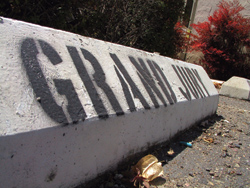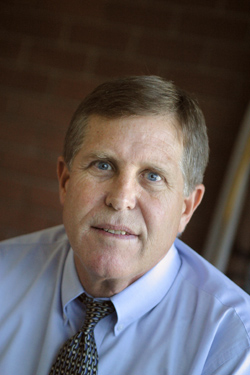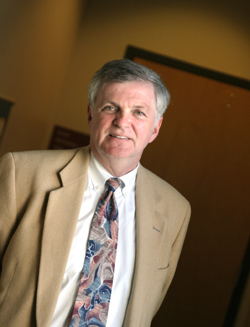Sniper
or savior?
The county’s grand jury is many things to many people
BY DANIEL BLACKURN
PHOTOS BY CHRISTOPHER GARDNER
In a tiny, nondescript, purposely understated, Mill Street bungalow tucked in the shadow of the county courthouse, a secret panel presides.
And while the faces on the San Luis Obispo County Grand Jury may change from year to year, its purpose doesn't vary much - rooting out various inadequacies in the bureaucracy, and suggesting cures. Spreading deliberations and investigations over an entire year, its 18 or so members aim at making life momentarily miserable for the few it finds deserving.
To some, like those who are the subject of a probe, the grand jury is a pesky but potentially lethal adversary. To others, it is a beacon of hope, a court of last resort.
But is a grand jury more bluff and bluster than bite? In San Luis Obispo County, that varies from year to year, from jury to jury.
Like its contemporaries in California's 57 other counties, the local grand jury is an official nag, taking on the onerous task of representing the people's interest within the wheelhouse of government.
In this county, as in the other 57 California counties, grand juries are established under the authority of the superior court. The panelists operate independently of any other civil power, and only a judge can regulate their activities.
So, just what is this thing called a grand jury, reputed to be capable, in the words of some cynics, of indicting a ham sandwich?
California law provides for the establishment of grand juries for three reasons: indicting persons accused of crimes; making accusations of malfeasance against public officers; or putting local government agencies under the investigative microscope.
Most grand jury activities in this state center around the latter function, that of civic "watchdog."
California law grants much wider authority to probe civil institutions than any other state in the Union.
 |
BEHIND CLOSED DOORS The innocuous office of the San Luis Obispo County Grand Jury, tucked away on Mill Street in San Luis Obispo. |
According to the Website of the California Grand Jurors Association (CGJA), the grand jury "is itself a remarkable institution. Praised by some as the protector of the citizenry against arbitrary prosecution, the grand jury involves ordinary citizens in the administration of criminal justice, and, in California, the civil grand jury gives ordinary citizens the power to investigate local political entities to root out corruption."
The grand jury has several distinct weapons helpful in carrying out its assignment. First, it can and does operate in near-complete secrecy. It has subpoena powers and the authority of the court behind it. It can do darned near anything it wishes. When its work is done, a grand jury publishes its conclusions and simply fades into oblivion, making way for an updated model.
"A grand jury is a tempest that seems to stay in a teapot," said Jim McKiernan, a San Luis Obispo lawyer and former SLO County court executive officer and jury commissioner. "Things never really bubble out into the public. Issues never seem to be resolved. Then the pot boils over again next year with the next report. A lot of time and money has been spent, but nothing ever happens."
McKiernan said he thinks the grand jury "performs the function of a job performance analysis."
The musings of a grand jury often do slip by without much of a flap - a story or two in the newspapers, a 40-second hit on local television - and the year's work fades swiftly into oblivion, a passing blip on people's radar.
So while its potential targets might not particularly fear a panel of ordinary citizens considered by many to be a toothless tiger, no one can ever foresee what a jury might try. That unpredictability makes a grand jury inherently dangerous. To paraphrase a basic physics law, for every action there is a grand jury reaction.
* * *
Though it is an entity that prides itself on maintaining a high degree of secrecy, this county's grand jury has found itself front and center lately after its 2003-04 version launched a very public blitzkrieg in June heaping criticism on the practices of two high-visibility local public agencies.
According to the recently disbanded grand jury's findings, the Department of Social Services' Child Welfare Division, and the District Attorney's Office, are riddled with administrative deficiencies.
It was an opinion that did not find a receptive audience from Lee Collins, the county's social services director. Collins' reaction to the report was loud, swift and unmistakable: "It really pissed me off," he said of the report after he had cooled down.
At issue is a basic philosophical difference, said Collins, centering around the question of either placing children in foster homes, or trying to salvage a family environment.
IN THE CROSS HAIRS
|
 |
"The grand jury would have us go backwards," said Collins, who favors all-out efforts to maintain family integrity by keeping families and siblings together, as opposed to foster care. "We will not go backwards. The system sucks. It's not working and we have to change it."
And, adds Collins, "That is in large part why my reaction to the grand jury report, probably ill advised in retrospect, was as vehement as it was. Children thrive with their family when we can keep them safe and give them support . better than they do with really good strangers."
Jury Foreman Myron Gilbert called the report "really balanced" and insisted the grand jury panel "had no agenda." He has declined to comment further to reporters.
However, Collins' acerbic collision with the grand jury is proving revealing because it is involving panel officials in an ongoing public defense of their document.
As in prior years, Collins was given an advance copy of the report, in mid-June, a week before its public release . and, as usual, he was told the report was embargoed, meaning he couldn't say anything about it. The Department of Social Services is one of several public agencies examined by the grand jury annually, so Collins has been through the process, by his own estimate, 23 times. But that didn't blunt the current blow, he said recently.
He spent a week muzzled, near maniacal, he said, forced by law to remain silent as he read the copy of a report he viewed as the product of "an act of cowardice."
"I met with the grand jury early in the year," said Collins. "I told them they had the responsibility and the opportunity to describe not just the bad, but to shine the light on things that are going well."
Collins said he presented data and reports that "showed how the department was doing in relation to the rest of the state."
None of his information made it into the report, said Collins, "and some of the material that [the grand jury] printed was clearly opposed to the hard data that I made available to them."
That, said Collins, "really pissed me off. They should have had the courage, when they were finalizing their report, to call me back and say, 'Look, Collins, this is what we are hearing. What do you say about this?' I thought is was an act of cowardice not to confront me with what they thought they had found."
Collins found that omission personally offensive. "I'm not as political as I could be," he said. "I try not to bullshit people and I don't like it when they are doing it to me. I like straight talk. But I guess I could have smoother edges."
By the time the jury distributed its report publicly, Collins had worked himself into a fine state of mind. He fired back with a 44-page response in which he disputed the grand jury's findings point by point.
Now he figures he might have overreacted, but he still believes he's walking around with a target on his back.
"I'd be lying if I said that I never feel that way," said Collins. "Does it feel personal sometimes? Yeah, the grand jury made it personal because they went after me personally. But I think it has less to do with me as a person, than as my symbolic presence as head of an agency that has been undergoing a lot of changes."
VOCIFEROUS CRITIC |
|
The director sees a "cookie-cutter" pattern to the grand jury's avenue of investigation of his agency.
"Several counties have had grand jury reports around their child welfare systems. And when you read those [reports] it is clear that grand jury members from county to county are talking with one another. The reports all have eerily similar wording, and a [common] theme. If these were copyrighted reports, they would be suing one another."
After he read the report, said Collins, he sent the grand jury a letter.
"I told them opinions are one thing, and facts are another. A lot of the 'facts' are just dead wrong. Let's correct those and the report will make a lot more sense."
The jury, said Collins, did not respond.
* * *
Also in the crosshairs of last season's jury was District Attorney Gerald Shea.
Shea's office was found derelict by the grand jury for its handling of the Sarah Scruggs case. Scruggs, 17, was fatally struck in Grover Beach crosswalk by a vehicle driven by Kenneth Freitas, the 33-year-old son of county tax collector Frank Freitas.
The case was stalled at the district attorney's desk for six months and nearly missed a statute deadline for filing.
After claiming a conflict of interest and bouncing the case to the state Attorney General - who declined to prosecute - Shea decided to file a single count of vehicular manslaughter. A San Luis Obispo County criminal jury recently found the younger Freitas guilty of the charge. He will be sentenced Aug. 31.
The grand jury entered the case at the behest of Sarah's mother, Elizabeth, who gathered more than 700 signatures in a successful effort to get the panel to investigate what she believed were deficiencies in the district attorney's policies.
"The whole thing would have gone away, just disappeared, if it had not been for the grand jury's very special attention to my daughter's case," said Elizabeth Scruggs recently. "Thank God for the Grand Jury."
That investigation by the 2003-04 Grand Jury posed a problem for the County Counsel, the legal office that represents grand jury functions, because Counsel lawyers generally work in concert with district attorney deputies.
The jury found fault with numerous administrative policies and procedures, most of which Shea said he corrected even before issuance of the jury's report.
Assistant County Counsel Jac Crawford said that his office reviewed the jury's report on the district attorney "in the usual way, for libel."
"The grand jury has really helped a lot of county departments with their financial work," said Williams. "All the county departments that have had that kind of advice from the jury has implemented the advice and found it to be really worthwhile. Grand juries really do a real through job."
Kip Chase, foreman of the 2002-03 Grand Jury, noted that juries "are limited to government analysis in this county. State, federal affairs . we don't do it. But if something pertains to any public agency in the county, cities, special districts, police and sheriff . we have a lot of authority, yes, but it is limited."
Chase, interviewed last year, said he was limited in what he can say, because a grand juror's oath "is for life." But he didn't hesitate to parse the problem in San Luis Obispo County, as he sees it.
"The main difficulty, as far as we were concerned, is that we had no authority as far as enforcement," Chase said. "If we discovered some misbehavior, all we could do is note what we discovered, and make a recommendation. That is a cause of frustration." ³
Senior Editor Daniel Blackburn can be reached at [email protected].
